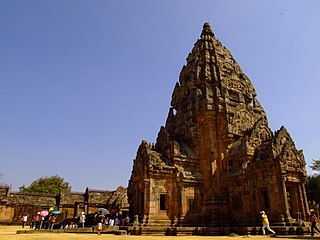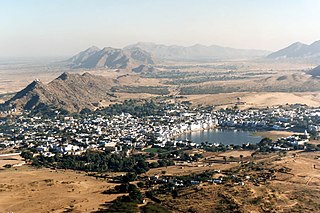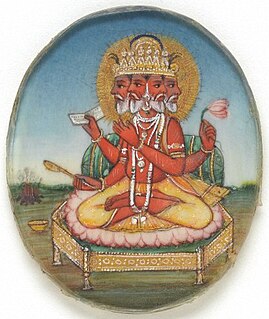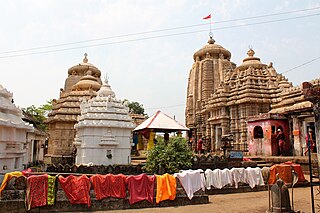
The Ardhanarishvara, is a form of the Hindu deity Shiva combined with his consort Parvati. Ardhanarishvara is depicted as half-male and half-female, equally split down the middle. The right half is usually the male Shiva, illustrating his traditional attributes.

Phanom Rung, or full name, Prasat Hin Phanom Rung, is a Hindu Khmer Empire Temple complex set on the rim of an extinct volcano at 402 metres (1,319 ft) elevation. It is located in Buriram Province in the Isan region of Thailand, and was built at a time when Khmer social-political influences were significant in Srisaket. It was built of sandstone and laterite between the 10th and 13th centuries. It was a Hindu shrine dedicated to Shiva, and symbolises Mount Kailash, his heavenly dwelling. The Phanom Rung sanctuary compound was constructed over several phases, dated by means of iconography of its art and architectural styles together with its inscriptions. These comprise two foundations of sacred brick buildings of 10th century C.E., the minor sanctuary of 11th century, the central sanctuary built by king Suryavarman II’s relative Narentratitaya in 12th century and two Bannalais (libraries) of the 13th century. Further sacred buildings built in the reign of King Jayavarman VII in 13th century, including the Royal attire Changing Pavilion, the Kudi Rishis of Nong Bua Ray, the medical centre or hospital (Arokayasala) and Prasat Ban Bu, a rest house with fire where travelers could shelter (Dharmasala) on the plain at the foot of Phanom Rung, alongside the road linking Angkor and Phimai. These evidence an important vice-regal centre on and around the mountain that flourishes from the 10th to the 13th centuries.

Sringeri also called Shringeri is a hill town and Taluk headquarters located in Chikkamagaluru district in the Indian state of Karnataka. It is the site of the first maṭha established by Adi Shankara, Hindu theologian and exponent of the Advaita Vedanta philosophy, in the 8th century CE. Located on the banks of the river Tungā, the town draws a large number of pilgrims to its temples of Sri Sharadamba, Sri Vidyashankara, Sri Malahanikareshvara and other deities.

Pushkar is a city in the Ajmer district in the Indian state of Rajasthan. It is situated about 10 km (6.2 mi) northwest of Ajmer and about 150 kilometres (93 mi) southwest of Jaipur. It is a pilgrimage site for Hindus and Sikhs. Pushkar has many temples. Most of the temples and ghats in Pushkar are from the 18th century and later, because many temples were destroyed during Muslim conquests in the area. Subsequently, the destroyed temples were rebuilt. The most famous among Pushkar temples is the red spired Brahma Temple. It is considered a sacred city by the Hindus particularly in Shaktism, and meat and eggs consumption are forbidden in the city. Pushkar is located on the shore of Pushkar Lake, which has many ghats where pilgrims bathe. Pushkar is also significant for its Gurdwaras for Guru Nanak and Guru Gobind Singh. One of the bathing ghats is called Gobind ghat built by the Sikhs in the memory of Guru Gobind Singh.

Brahma Temple, Pushkar is a Hindu temple situated at Pushkar in the Indian state of Rajasthan, close to the sacred Pushkar Lake to which its legend has an indelible link. The temple is one of very few existing temples dedicated to the Hindu creator-god Brahma in India and remains the most prominent among them.

Ashtabujakaram or Ashtabuja Perumal Temple located in Kanchipuram in the South Indian state of Tamil Nadu, is dedicated to the Hindu god Vishnu. Constructed in the Dravidian style of architecture, the temple is glorified in the Divya Prabandha, the early medieval Tamil canon of the Azhwar saints from the 6th–9th centuries AD. It is one of the 108 Divyadesam dedicated to Vishnu, who is worshipped as Ashta Bhuja Perumal and his consort Lakshmi as Alamelumangai.

Tiruvekkaa Temple or Yathothkari Perumal Temple is a Hindu temple located in Kanchipuram in the South Indian state of Tamil Nadu and dedicated to the Hindu god Vishnu. Constructed in the Dravidian style of architecture, the temple is glorified in the Divya Prabandha, the early medieval Tamil canon of the Azhwar saints from the 6th–9th centuries CE. It is one of the 108 Divyadesam dedicated to Vishnu, who is worshipped as Yathothkari Perumal and his consort Lakshmi as Komalavalli.

Hara Saabha Vimochana Perumal Temple in Thirukandiyur, a village in the outskirts of Thiruvayaru in the South Indian state of Tamil Nadu, is dedicated to the Hindu god Vishnu. Constructed in the Dravidian style of architecture, the temple is glorified in the Divya Prabandha, the early medieval Tamil canon of the Azhwar saints from the 6th–9th centuries AD. It is one of the 108 Divyadesam dedicated to Vishnu, who is worshipped as Hara Saabha Vimochana Perumal and his consort Lakshmi as Kamalavalli Nachiyar.

Brahma is a Hindu god, referred to as "The Creator" within the Trimurti, the trinity of supreme divinity that includes Vishnu, and Shiva. He is associated with creation, knowledge, and the Vedas. Brahma is prominently mentioned in creation legends. In some Puranas, he created himself in a golden embryo known as the Hiranyagarbha.
Sri Biranchinarayan Temple is in Palia village, which is located 15 kilometres (9.3 mi) south of Bhadrak District, Odisha, India on the way from Bhadrak to Chandabali. It occupies a significant place in the cultural map of Odisha state of India. Today, the standing Biranchi Narayan Temple stands as evidence of the heritage of Surya Upasana in Odisha. Biranchi Narayan is another name for Lord Surya, the Sun God of light and lustre. The existing temple is dedicated to Biranchi-narayan, who is enshrined as a roughly four-faced image of the Sun. A square stone slightly tapering towards the top contains four carved images of the Sun god in relief, on the four sides of a slab. The figures hold two lotuses in two hands, as usual, and are depicted standing on chariots drawn by seven horses. Architecturally, the temple can be dated to the 13th century. It was renovated and reconstructed in the beginning of the 20th century by the generosity of a local zamindar.

Madhava Temple,, is the temple dedicated to Lord Vishnu. It is located at the Madhab village of Niali block in Cuttack district, Odisha.

The Kapilesvara temple is a Hindu temple dedicated to Shiva located in the south western outskirt of the village Kapilesvara, Old Town, Bhubaneswar, Odisha, India. It is located at the end of Kapilesvara road leading from Lingaraj temple to Kapilesvara Village. The presiding deity is a Siva-lingam at the center of a circular yonipitha inside the sanctum. It is a living temple, facing towards east and maintained by Kapilesvara Temple Trust Board. The temple is situated within the precinct along with 33 other monuments. The precinct is located on the northern embankment of Manikarnika tank over an area of 44.00 square metres.
Brahma Temple may refer to:
Nila Madhava is a murti that was in the possession of a tribal king, Biswabasu. Scriptures says that, after Lord Krishna wound up his manifested pastimes, he took a shape of Lord Vishnu. Biswabasu found this stone and felt its divinity. So he started worshiping it and name it Lord Nila Madhava. This brahma was later fetched by King Indradyumna by Brahmin Bidyapati for the creation of Lord Jagannath's idol. It has been kept inside a small chamber inside the Lords idol. It is believed that it is still present inside the Lord's idol and is transferred to the new idol after every 12 years.

Alampur Navabrahma Temples are a group of nine early badami Chalukyan Hindu temples dated between 7th-century and 9th-century that are located at Alampur in Telangana,India, near the meeting point of Tungabhadra River and Krishna River at the border of Andhra Pradesh. They are called Nava-Brahma temples though they are dedicated to Shiva. They exemplify early North Indian Nagara style architecture with cut rock as the building block.The temples of alampur resembles the style of pattadakal,aihole style as they were karnata dravida,vesara style native to Karnataka.
The Mithrananthapuram Trimurti Temple is a Hindu temple complex in Thiruvananthapuram, Kerala, India. It is a temple in where devotees get to offer worship to all the three Trimurti deities, namely,. The Temple is located on the western side of Padmanabhaswamy temple in Thiruvananthapuram.

Vaikuntha Chaturmurti or Vaikuntha Vishnu is a four-headed aspect of the Hindu god Vishnu, mostly found in Kashmir. The icon represents Vishnu as the Supreme Being. He has a human head, a lion head, a boar head and a fierce head. Sometimes, even three-headed but aspects of Vishnu where the fierce rear head is dropped are considered to represent Vaikuntha Chaturmurti. Though iconographical treatises describe him to eight-armed, he is often depicted with four. Generally, Vaikuntha Chaturmurti is shown standing but sometimes he is depicted seated on his vahana (mount) Garuda.
Niali is a Tehsil headquarter in Cuttack district of Odisha. It is famous for the shrine of Sobhaneswar, a Shiva Temple. Niali is situated at a distance of 42 km from Cuttack, the district headquarters.It is also knows as Mendha Khetra.
Kaal Bhairav Mandir is one of the oldest Shiva temples in Varanasi, India. Situated in Bharonath, Vishweshwarganj (Varanasi), this temple has great historical and cultural importance in Hinduism; especially amongst the locals. The temple is dedicated to Bhairava, a fierce form of Shiva and wears a garland of skulls and carries a club of peacock feathers. The word "Kaal" means both "death" and "fate". Kaal Bhairav also means the one whom even death Fears It is believed that even death is afraid of Kaal Bhairav.












